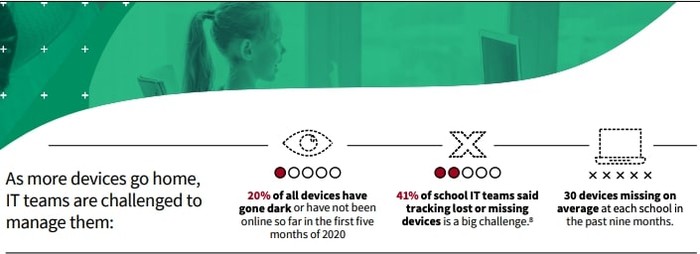The global pandemic accelerated K–12 education’s digital transformation.
With remote and hybrid learning turning mainstream, today’s teachers and students are increasingly reliant on mobile devices and digital tools. Efforts to close the homework gap are more urgent than ever, and cyberthreats — particularly ransomware attacks — are only intensifying.
These unprecedented changes also make it clear that IT teams must be equipped with the right tools to support the success of students and educators in this new learning environment, according to a report by Absolute, an endpoint security solutions company.
“Operational agility is the new critical capability for all IT teams to be able to respond to changing conditions and seamlessly transition between models,” said Christy Wyatt, Absolute’s president and CEO, in a press release announcing the report.
The report, titled “Distance Learning’s Impact on Education IT,” analyzes anonymized data from approximately 5.1 million Absolute-enabled devices across 10,000 schools and districts. It provides key insights on pain points with device and application use during remote learning — knowledge to help IT teams better understand and act on the tech challenges facing K–12 education in this unique school year.
Based on the data and research gathered for the report, Absolute highlights four key takeaways:
- IT teams are doing more with less.
- They are facing significant challenges with tracking and managing devices, software and applications remotely.
- Remote learning has created new tech support challenges, taking away valuable instructional time and causing teacher frustration.
- Network-based security controls aren’t enough to protect end users in remote environments.
Here’s a closer look at their some of their findings and analysis.
IT Teams Face New Challenges in Remote Environments
Absolute found that IT staff in both large and small school districts are supporting remote learning on tighter budgets, with fewer resources. While federal stimulus packages may help in the short term, long-term budgets are still uncertain for many, according to the report. Schools are facing increased expenses; experts point to $500 incremental increases per student in distance learning costs for this school year.
IT teams are now managing more devices too. A solid majority (80 percent) of schools have purchased or plan to purchase more devices for remote learning, the report notes. But as more devices go home for longer periods of time, IT visibility into device management and security has decreased. For instance, between January and May 2020, 20 percent of all educational devices have gone dark or were not online, according to Absolute’s data. Schools also have had an average of 30 devices go missing at some point in the last nine months.
DISCOVER: Learn about the value of taking a tech inventory.
Furthermore, Absolute saw an increase in IT teams using retired devices to ensure all students and educators were ready for remote learning and remote work. But older devices are more vulnerable to security threats. “It is unlikely that these older devices have the most recent patches, security updates and application versions installed — increasing the risk factors of an already expanded fleet,” the report notes.
The report also highlights a survey from the Education Week Research Center which found that teachers are spending more time troubleshooting technology problems than they did when they taught in person. And with many schools operating IT help desks remotely, it’s been harder to address these problems. “Since IT doesn’t always have physical access to devices, troubleshooting and remediating issues is more difficult,” according to the report.
READ MORE: See how student-run IT help desks are helping troubleshoot remote learning.
Device security has also been more challenging and complex for IT teams. For example, 46 percent of schools have at least one device that uses rogue VPNs or web proxy applications such as NordVPN and CroxyProxy — a 4 percent increase from 2019, according to the report. These applications are typically used to evade security protocols and policies that IT teams put in place and can make devices more vulnerable to security threats.
Additionally, more IT teams are deploying remote management solutions to manage more devices and applications outside the school network. Absolute found that there was an 87 percent increase in the number of school devices with remote management applications between early in the 2019-2020 school year and the end of the year. This uptick should be a concern because ransomware attackers tend to abuse remote desktop protocol connections to break into school systems, according to the report.
MORE ON EDTECH: Learn how to protect school systems from ransomware attacks.
“2020 signals a new chapter in education. The challenges we are seeing are not a minor blip — there will be no return to the pre-virus status quo,” the report notes. “As distance learning becomes a valuable part of a long-term strategy for student education, digital resiliency will become a key performance indicator (KPI) for schools.”












